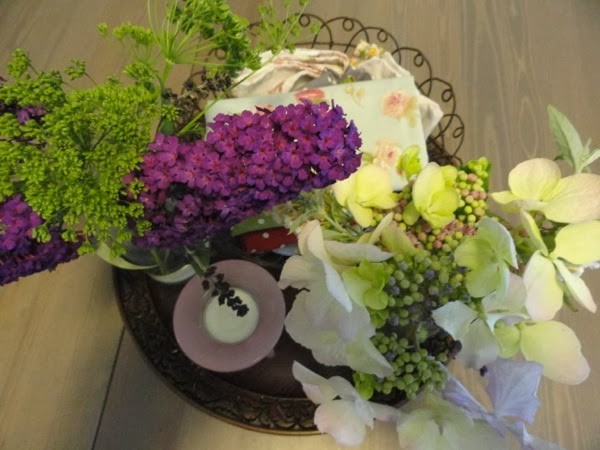I have been getting a few emails over the past couple of months asking about slowing down and taking time out in the day to relax. It seems to be a mystery to some people. I have written back saying to just do it - leave your work behind and put your feet up, knit, sew, walk, paint, garden - do what your life allows you to do. I'm aware many of you have young children and I'd never tell you to walk away from them, but you could take them outside and walk or garden. When we look after Jamie, who will be three years old at the end of March, he loves to be outside in the garden with us. He likes helping, so we create small tasks for him so he feels a part of us and our garden. We both feel relaxed in the garden and we show him how to work slowly, sit and talk and generally to be part of that natural setting without impacting on it too much with noise and busyness. If you're snow bound inside you could knit or sew while your child plays. If these measures won't work for you, ask your partner, best friend, mother or sister to look after your child for an hour and do what you want to do. And do it regularly, giving something back in return.
But if you can't get away outside or have someone help, make tea in a pot. Tea will slow you down. You can do this alone or with a child. When Jamie is here, he drinks "special tea" which is just our tea from the pot, with a lot of milk and a small amount of honey. He loves it.
Above and below are photos of my favourite tea pot of all time. I got it from my sponsor's shop Odgers and McClellend just before Christmas. It's had a workout since then. :- ) It's got an excellent no-drip spout and it's just the right size for Hanno and me, plus Jamie when he's here. It's enamel so I'll have to make a tea cosy for it in winter, but I'm looking forward to doing that. I've got a few tea pots and it's possibly the cheapest of all of them, but it will be my daily pot for many a long year to come. I feel very comfortable with it on my tea tray.

The challenge here is to make a pot of tea. Don't use tea bags, or if you're making coffee, make a pot of coffee, not instant coffee. Anyone can make a cup of tea with a tea bag and even though I've had my fair share of them, it's not the same as drinking good loose leaf tea, made in a pot. I stopped using tea bags a few years ago and I've never regretted it. My tea is better now, I love the ritual of it, it slows me in a gentle and practical way, and then I get to sit and drink it. Fast and instant may be good in certain circumstances but if you want to relax, they won't come close to helping you do that.
When you make tea, you have to wait. Waiting is good for us. It means we're doing nothing and in that nothing time you can stand there thinking, or look out the window, or slowly set a tray with the pot, tea strainer, spoons, tea pot, cups and whatever else you're serving. You can breathe deeply.
So, you've waited for the kettle to boil. Pour a small amount of boiling water into the clean pot, swish it around to make the pot hot, then pour the water into the sink. Add your tea leaves - one for each person and if, like us, you like strong tea, one of the pot as well. Pour the boiling water over the tea leaves, give it a quick stir with tea spoon, and put the lid on the pot. And now? Now you have to wait for it to brew. While you're waiting, take the tray to where you'll sit. After a couple of minutes, pour the tea.
Now you can do whatever you want to do - just sit there with your cup in hand, talk, watch the birds coming and going, if you're alone and you're not used to that, listen to the radio (very quietly and not music), or you can knit, embroider, hand stitch, write or do nothing but relax. Think about what you're doing - you're consciously taking a break because you need it and deserve it. Breathe deeply and take it all in.
While you're there thinking, think about your own happiness or contentment. You are responsible for that - no one else will walk up to you at any point in your life and serve you happiness and contentment on a silver platter. You're in charge of it. I'm not saying you selfishly squander your days giving yourself rest breaks and gifts and think that everyone else should care for you. We're adults, we're self-reliant, we do as much for ourselves as we can, including cultivating happiness and contentment.
Tea making in a pot is a small and gentle way of giving yourself time to relax. It's the tea ceremony as much as the tea that does it. This ritual that will have you waiting when no one waits nowadays. It will help slow you - first when you wait for the water to boil, then when you wait for the tea to brew, and then in the drinking of it and the feelings of relaxation that come from that. When you finish, feel thankful that you had time to look after yourself and promise that you'll do it again tomorrow. Soon it will become a habit and who knows what could happen if you're relaxed and happy!
Will you try?






















































